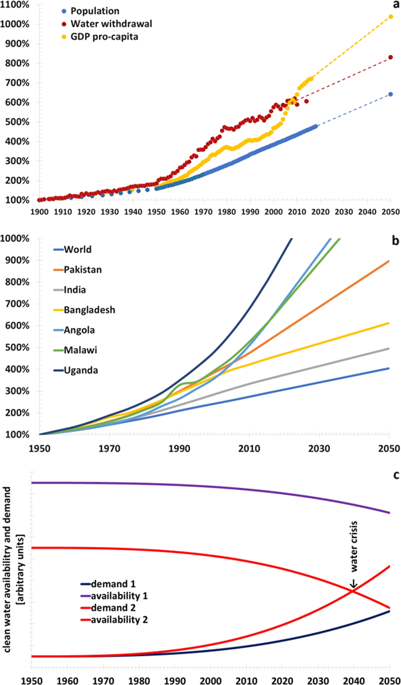npj Clean Water ( IF 10.4 ) Pub Date : 2019-07-31 , DOI: 10.1038/s41545-019-0039-9 Alberto Boretti , Lorenzo Rosa

|
The 2018 edition of the United Nations World Water Development Report stated that nearly 6 billion peoples will suffer from clean water scarcity by 2050. This is the result of increasing demand for water, reduction of water resources, and increasing pollution of water, driven by dramatic population and economic growth. It is suggested that this number may be an underestimation, and scarcity of clean water by 2050 may be worse as the effects of the three drivers of water scarcity, as well as of unequal growth, accessibility and needs, are underrated. While the report promotes the spontaneous adoption of nature-based-solutions within an unconstrained population and economic expansion, there is an urgent need to regulate demography and economy, while enforcing clear rules to limit pollution, preserve aquifers and save water, equally applying everywhere. The aim of this paper is to highlight the inter-linkage in between population and economic growth and water demand, resources and pollution, that ultimately drive water scarcity, and the relevance of these aspects in local, rather than global, perspective, with a view to stimulating debate.
中文翻译:

重新评估《世界水发展报告》的预测
2018年版的《联合国世界水发展报告》指出,到2050年,将有近60亿人遭受清洁水短缺。这是对水资源的需求不断增加,水资源减少以及水污染加剧的结果。人口与经济增长。有人认为这个数字可能被低估了,到2050年清洁水的短缺可能会更加严重,因为这三种缺水驱动力以及不平等的增长,可及性和需求的影响被低估了。尽管该报告提倡在不受限制的人口和经济增长中自发采用基于自然的解决方案,但迫切需要规范人口和经济,同时执行明确的规则以限制污染,保护含水层和节约用水,同样适用于任何地方。本文的目的是强调人口与经济增长与水需求,资源与污染之间的相互联系,这些相互联系最终导致水资源短缺,并以地方而不是全球的角度探讨这些方面的相关性,以期激发辩论。









































 京公网安备 11010802027423号
京公网安备 11010802027423号